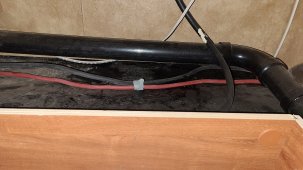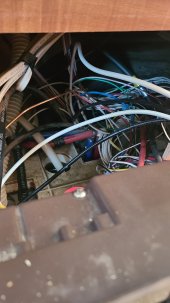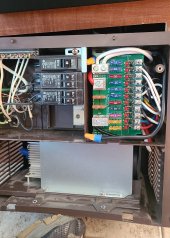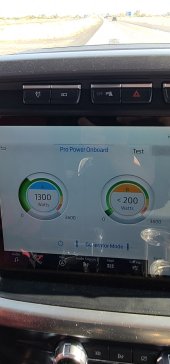Earlier this year the wife and I began dry camping (aka boondocking) and we now prefer this over RV parks. About this same time the lead acid batteries that came with the trailer were failing and it seemed like a good time to upgrade the power system.
The initial idea was to just put a couple of lithium batteries on the trailer tongue, in place of the old SLAs. Next, I began designing a build with significant solar capability and even purchased a Growatt 24V 3000W all-in-one as the basis for the project.
In the end I decided on a less expensive and somewhat simpler build described below.
First though, some shout-outs to others who helped. To @Short_Shot , @eXodus , @HRTKD , @Zwy and @12VoltInstalls, all who helped me think this though and not do something stupid, like building something that didn’t really meet my goals. A double shout-out goes to @smoothJoey who patiently shared both his time and expertise to this build. Thanks guys, for your help! And I am happy to report there was no smoke, no fire, and not a single blown fuse!
Here are the main components of this build:
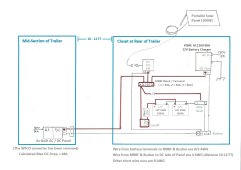
After considering various locations for these components, the only good place was a small storage area at the rear of the trailer. This raised the issue of how to fit the above design into a space just 18 inches wide, 20 inches deep, and 23 inches high.
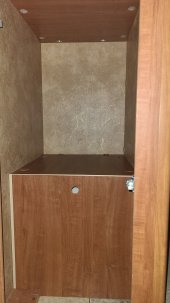
Since there wasn’t room to put all the components on a single board (as you see in the Will Prowse videos), I went with a stacked design. That is, two 18x20 inch boards with risers on the lower board to support the upper board.
Here is the physical layout of each board.


Once built, it looks like this.
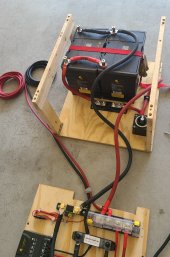
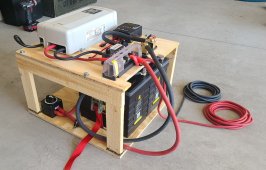
NOTE: in these photos the shunt for the BMV-712 is wired backwards. Until I swapped the connections the amp meter ran positive when consuming and negative when charging.
The build was progressing and seemed fairly clean and compact. Then came a major snag! How could I have missed this? The opening of the storage area is smaller than the interior space. The design would fit the internal space very nicely – if only I could get it through the opening. After a short time of consternation, the proverbial light bulb went on. Hinges could be added to the risers on the lower board, allowing them to fold down, thus fitting through the opening and unfolding once in place.
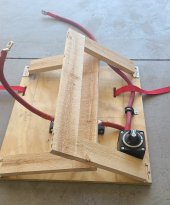

Here the lower half is installed, and the cables that need to connect to the upper board are hanging from a couple of cup hooks at the top of the storage space.
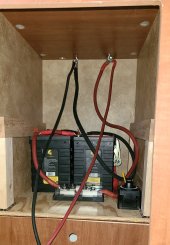
Then, the upper board going in.
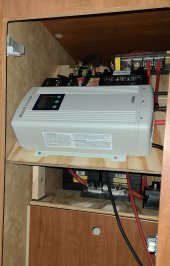
... continued below.
The initial idea was to just put a couple of lithium batteries on the trailer tongue, in place of the old SLAs. Next, I began designing a build with significant solar capability and even purchased a Growatt 24V 3000W all-in-one as the basis for the project.
In the end I decided on a less expensive and somewhat simpler build described below.
First though, some shout-outs to others who helped. To @Short_Shot , @eXodus , @HRTKD , @Zwy and @12VoltInstalls, all who helped me think this though and not do something stupid, like building something that didn’t really meet my goals. A double shout-out goes to @smoothJoey who patiently shared both his time and expertise to this build. Thanks guys, for your help! And I am happy to report there was no smoke, no fire, and not a single blown fuse!
Here are the main components of this build:
- 2 Lion Energy UT1300 12V LFP 150A 105AH batteries
- KISAE AC1260 60A 12V Battery Charger (from the good folks at donrowe.com)
- 100W portable solar panel and basic SCC
- Victron BMV-712 Smart Battery Monitor
- Blue Sea 5196 MRBF Fuse Block – 3 Circuits
- Class T fuse block with 150A fuse (also available from Don Rowe)

After considering various locations for these components, the only good place was a small storage area at the rear of the trailer. This raised the issue of how to fit the above design into a space just 18 inches wide, 20 inches deep, and 23 inches high.

Since there wasn’t room to put all the components on a single board (as you see in the Will Prowse videos), I went with a stacked design. That is, two 18x20 inch boards with risers on the lower board to support the upper board.
Here is the physical layout of each board.


Once built, it looks like this.


NOTE: in these photos the shunt for the BMV-712 is wired backwards. Until I swapped the connections the amp meter ran positive when consuming and negative when charging.
The build was progressing and seemed fairly clean and compact. Then came a major snag! How could I have missed this? The opening of the storage area is smaller than the interior space. The design would fit the internal space very nicely – if only I could get it through the opening. After a short time of consternation, the proverbial light bulb went on. Hinges could be added to the risers on the lower board, allowing them to fold down, thus fitting through the opening and unfolding once in place.


Here the lower half is installed, and the cables that need to connect to the upper board are hanging from a couple of cup hooks at the top of the storage space.

Then, the upper board going in.

... continued below.





